Group Theory and Symmetry, Part III: Representations and Character Tables
In the third part of this series, David Ball starts getting into the mathematical aspects of group theory, aspects that ultimately become useful in spectroscopy.

In the first installment of this series (1), I introduced the five fundamental symmetry elements that we consider for physical objects. In the second installment (2), I discussed why these symmetry elements form mathematical groups. Here, we will extend the group concept in terms that can be used more mathematically — ultimately, a form that can be used in spectroscopy.

David W. Ball
Matrix Representations — Again
In the last column, I made the point that a symmetry operation can be represented by matrix multiplication. This is a point worth making again, so here is a quick review. Consider the point (3, 4) in two-dimensional space, as shown in Figure 1a. If a reflection plane of symmetry σ were to cut the plane of the page coincident with the y axis, that point would be reflected to the point (-3, 4). This is equivalent to performing the following matrix multiplication:

(You may want to review the procedures for performing matrix multiplication.) The 2 x 2 matrix in the equation above is a matrix representation of σ, the reflection symmetry element.
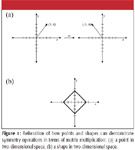
Figure 1
Figure 1b shows that this concept is not limited to points, but to shapes as well: if every point on the shape in Figure 1b, represented by (x, y), were operated on by the 2 x 2 matrix element representing σ, it would transfer every point to another point on the shape. That is, the expression

holds for each and every point on the shape. Therefore, the shape has a reflection symmetry element. Furthermore, if this equation were not true for every point on the shape, the shape would not have the symmetry element σ.
As was mentioned in the last installment, matrix multiplication is extendable to three dimensions and appropriate to all five symmetry elements.
Moving On: Representations
Spectroscopy deals with atoms and molecules. How do we construct matrix multipliers for molecules that have symmetry? Consider the C2 axis of symmetry for the hydrogen molecule H2 as shown in Figure 2a. Performing the symmetry operation switches the two hydrogen atoms, which have "a" and "b" labels to better see the switch. This suggests that the matrix multiplication that represents this symmetry operation is simply

where the C2 symmetry operation is represented by the 2 x 2 matrix on the left. However, this is overly simplistic. That's because when we are talking about molecular properties, like spectroscopic properties, many (most?) of them are vector properties (3). This means that direction matters, not just position. The better way to represent the H2 molecule is presented in Figure 2b, with each atom having a set of unit vectors representing the positive x, y, and z axes superimposed on it. (The y axis should be pictured as going behind the plane of the page.) On the left side, the unit vectors on the original atoms are all pointing in the positive directions. However, after operating on the molecule with the C2 symmetry element as shown on the right side, not only have the two atoms exchanged positions, but some of the unit vectors have switched to the negative directions (as shown by the minus signs on the appropriate axis labels).
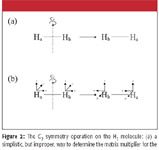
Figure 2
Instead of a 2 x 2 matrix to represent the two hydrogen atoms, we really need a 6 x 6 matrix to represent not just the exchange of the atoms, but the effects on the unit vectors. The appropriate 6 x 6 vector is given in Figure 3. We concede that the matrix multiplier for C 2 is now more complicated than the 2 x 2 matrix first proposed. However, we also note two things: most of the matrix elements are zero, and the nonzero matrix elements show a pattern. This pattern can be described as a 3 x 3 "submatrix" that has the same form wherever it appears:

Note that the only nonzero elements are on the main diagonal of this square matrix. Although we have used the word previously, it will be defined formally here: the entire 6 x 6 matrix in Figure 3 that represents the C 2 symmetry operation is called a representation of the C 2 symmetry operation. It is not the simplest representation (as we'll demonstrate shortly), so it is also called a reducible representation.

Figure 3
As we have pointed out, the 3 x 3 matrix earlier is actually a simpler, more concise way of representing the entire 6 x 6 matrix in Figure 3. As such, the 3 x 3 matrix is also a representation of the C2 symmetry operation: we say that we have reduced the 6 x 6 representation to a simpler 3 x 3 representation. However, as we will see, it too is a reducible representation. The general 3 x 3 representations for each type of symmetry operation are what are given in Figure 4. Figure 4 reprints the general three-dimensional forms for each type of symmetry element (and includes information omitted its previous appearance [2]). Any given molecule's complete representation is given by a 3N x 3N matrix, where N is the number of atoms in the molecule. Each of the 3 x 3 matrices in Figure 4 will appear up to N times in a 3N x 3N matrix, with all of the other matrix elements being zero.

Figure 4
Another Example: H
2
O
The H2 molecule is potentially problematic for us, because it contains a C∞ axis coincident with the molecular axis, and infinities can be troubling to deal with. As another simple example, let us consider the H2O molecule, shown in Figure 5 with its unit axes labeled. Because we now have a three-atom molecule, our complete representation for a symmetry operation is going to be a 9 x 9 matrix. We have already established (1) that the H2O molecule has C2v symmetry, a point group that contains four symmetry elements: E, C2 ,σ, and σ'. The bottom part of Figure 5 shows how the unit vectors change with each of the indicated symmetry operations. Notice that the identity element E does nothing to the molecule and vectors, so there no change at all (but remember that E is a symmetry element that is required by the mathematical definition of a group! [2]). The C2 symmetry operation switches the two hydrogen atoms (again, labeled by "a" and "b" so we can keep track of them) and reverses the x and y unit axes on all atoms — even though the oxygen atom itself does not move, some of its axes do. The σ reflection plane is in the plane of the molecule, so while the atoms do not move, the y axes on all atoms are reflected to their negative directions. The σ' reflection plane bisects the H-O-H bond angle, so the hydrogen atoms are reflected onto each other and the x unit axes of all atoms are reflected to their negative directions.
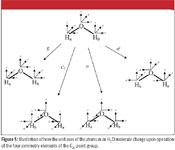
Figure 5
The matrix multiplication that leads to the vector changes in Figure 5 are given in Figure 6. Notice that, while each symmetry operation can be represented by a 9 x 9 representation, there is a simpler, different 3 x 3 matrix representation for each symmetry operation that is repeated three times in each complete representation. So while the 9 x 9 matrix is certainly complete information, it's nine times more numerical data than we need. We really only need the 3 x 3 matrices to understand how the unit axes are affected by the symmetry operations in the C2v point group.
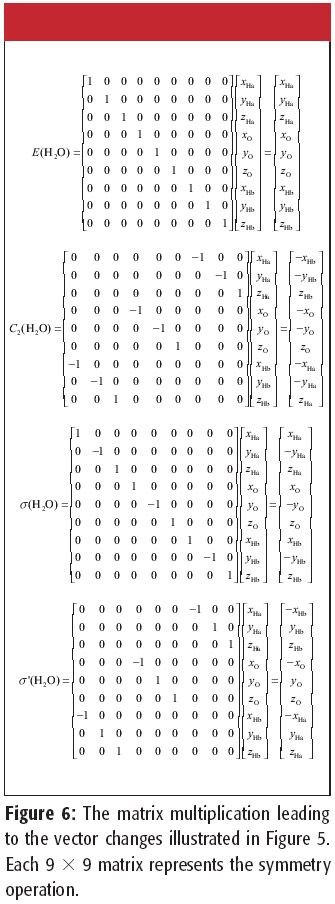
Figure 6
Here's the fun part: the same 3 x 3 matrix representations will be found for any object that has C2v point group symmetry. Consider diethyl ether, for example: C2H5OC2H5. It has C2v symmetry, too, just like H2O. Its complete matrix representation would be 3N x 3N = 3·15 x 3·15 = a 45 x 45 matrix = 2025 matrix elements! What you would find in that 45 x 45 matrix, however, is fifteen 3 x 3 blocks that are the same 3 x 3 matrices we found for the H2O molecule. Isn't group theory cool?
This same concept applies to any group of symmetry operations in any point group. Each symmetry operation will be defined by a 3 x 3 matrix that appears repeatedly in the complete 3N x3N representation. That's what Figure 4 is giving us; all we need to do is apply the correct angle for Cn and Sn axes, and put the -1 in the correct position for the different forms of reflection planes (see reference 1 for a discussion of the various types of reflection planes), and you've got the 3 x 3 matrix you need.
However, it can get even simpler than this. Even the 3 x 3 matrices are not the simplest way of representing the characteristics of the symmetry operations in a point group. What we are looking for is the simplest possible representation, the so-called irreducible representation. That is our next goal.
Another Way: Introduction of Character Tables
Looking at the atomic unit vectors is one way to understand how to simplify the representations of the point groups and their symmetry operations. Another way to construct a representation is to use numbers whose values will mimic the multiplication table of the symmetry elements in the point group. Again, to refresh you, Figure 7 reproduces the multiplication table for the C2v point group that we constructed in the last installment of this series (2). Any set of numbers that reproduces the patterns in Figure 7 is an acceptable representation; ultimately, we want to find the simplest set of numbers.
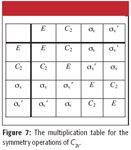
Figure 7
So, what if we set E = 1, C2 = 1, σ = 1, and σ' = 1? We get the multiplication table shown in Figure 8.
While trivial (everything is, after all, just one), the table in Figure 8 does mimic the overall structure of the multiplication table in Figure 7 — that is, we can break down the table above into four quadrants, and the structure of each quadrant is mimicked by the pattern of the numbers. So, the number set {1, 1, 1, 1} is a perfectly acceptable (though, again, trivial) representation of the symmetry elements {E, C2 , σ, σ'} in C2v .
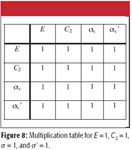
Figure 8
This is not the only set of numbers whose multiplication will mimic the structure of the table in Figure 7. If we set E = 1, C 2 = 1, σ = -1, and ?'= -1, we get the multiplication table shown in Figure 9. This table, too, mimics the structure of Figure 7 (although there is some ambiguity, because the same number represents two different symmetry elements), so the set of numbers {1, 1, -1, -1} serve as a representation of the symmetry operations in the C2v point group.
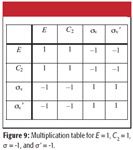
Figure 9
Two other sets of numbers can be easily constructed: {1, -1, -1, 1} and {1, -1, -1, 1} are two sets of numbers which, when taking the places of the symmetry operations in Figure 7, give results that mimic the distribution of products in the table. I will leave it to the reader to construct the multiplication table and verify that this is so. Let us try a set that does not work. If we consider the set {1, 0, 1, 0} to represent the four symmetry elements, we get the multiplication table shown in Figure 10, which, upon inspection, does not have the same general structure as the table in Figure 7. What this demonstrates is that not any random set of numerical values can be used in a representation.

Figure 10
There are other sets of numbers that can be used to represent the symmetry operation multiplication table, but the four sets of positive and negative ones presented so far are the simplest ones. As such, they are referred to as the irreducible representations of the point group. For any point group, the irreducible representations can be listed in a table, like the one shown in Figure 11. Each individual numerical value is called a character, so the table in Figure 11 is called the character table for that point group. Each irreducible representation has a letter label to identify it, here either an A or a B. These labels are called the Mulliken labels, after early 20th-century physicist Robert Mulliken. These are usually the symbols used by spectroscopists; another system of labels, based upon the capital Greek letter gamma Γ are called Bethe symbols and are used by a small fraction of scientists and engineers (although Γ is sometimes used to represent any general reducible representation).

Figure 11
Although the character table for the C 2v point group contains only 1s and -1s, character tables for other point groups can be other numerical values like 0, positive or negative 2 or 3, the imaginary root i (where i =√-1 ), an imaginary exponential, a sine function, or a 2 x 2 matrix. Figure 12 shows the complete character table for C 3v , which describes the symmetry of the ammonia molecule, NH3, and has some non-unit characters. Note that both axes of rotation and all three planes of reflection have the same sets of characters. When this is the case, we say that these symmetry elements involved belong in the same class. Only symmetry elements of the same type will ever be in the same class; that being said, E and i are always in classes by themselves because any shape that has E and i only has one E and one i symmetry element. Rather than listing all six symmetry elements of C 3v explicitly, we can combine the columns of symmetry elements in the same class and write a slightly more compact character table, also shown in Figure 12. Note that the third and fourth columns now represent more than one symmetry element, as indicated by the numeral before the symmetry element in the first row. In this case, E has only one element in its class, the C3 axes have two, and the reflection planes have three. It comes out as a simple fact that the number of possible irreducible representations in a point group equals the number of classes of symmetry elements. Also, although it is indeed trivial, every character table has as its first irreducible representation the one that has all +1s as characters. This is referred to as the totally symmetric irreducible representation.

Figure 12
Character tables are tabulated in many standard references in group theory, symmetry, physical chemistry, inorganic chemistry, spectroscopy, and other fields of science and mathematics. They summarize how the symmetry operations of a point group behave mathematically, and are the simplest way to do so. In our next installment, we will see how we can use the character tables to help us understand the behavior and properties of things that have symmetry.
David W. Ball is a professor of chemistry at Cleveland State University in Ohio. Many of his "Baseline" columns have been reprinted in book form by SPIE Press as The Basics of Spectroscopy, available through the SPIE Web Bookstore at www.spie.org. His book Field Guide to Spectroscopy was published in May 2006 and is available from SPIE Press. He can be reached at d.ball@csuohio.edu; his website is academic.csuohio.edu/ball.
References
(1) D.W. Ball, Spectroscopy 24 (12), 63–66 (2009).
(2) D.W. Ball. Spectroscopy 25 (1), 18–23 (2010).
(3) R.L. Carter. Molecular Symmetry and Group Theory (Wiley and Sons, Hoboken, New Jersey, 1998).

Statistics, Part I: First Foundation
October 1st 2015We present the first of a short set of columns dealing with the subject of statistics. This current series is organized as a “top down” view of the subject, as opposed to the usual literature (and our own previous) approach of giving “bottom up” description of the multitude of equations that are encountered. We hope this different approach will succeed in giving our readers a more coherent view of the subject, as well as persuading them to undertake further study of the field.
More Theory and Practice: The Thorny Problem of Mixtures and More on Straight Chain Alkanes
July 1st 2015Continuing the theory and practice themes from previous columns, the theory portion of this column will be a discussion of the proper way of handling the infrared spectral interpretation of mixtures. In my opinion, mixtures are the biggest obstacle to interpreting infrared spectra, and I will share with readers five tried-and-true techniques for dealing with them. The practice portion of the column will give the answer to the last installment’s problem, and complete the spectral analysis of straight chain alkanes.